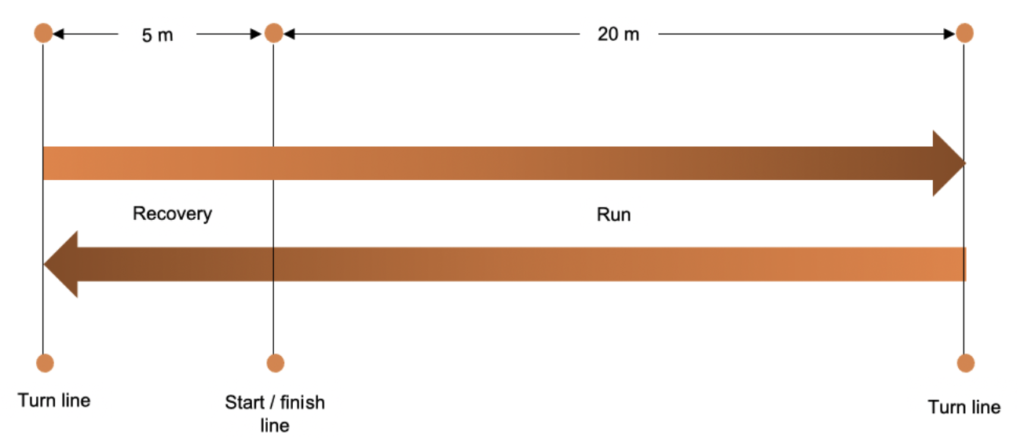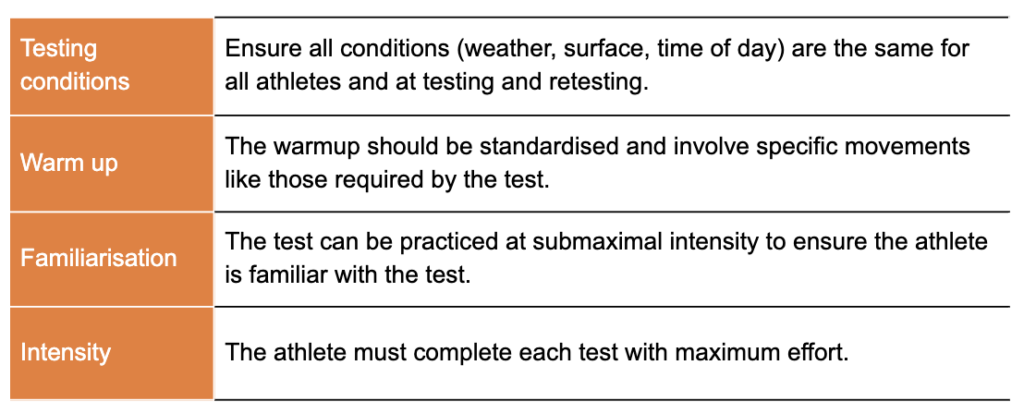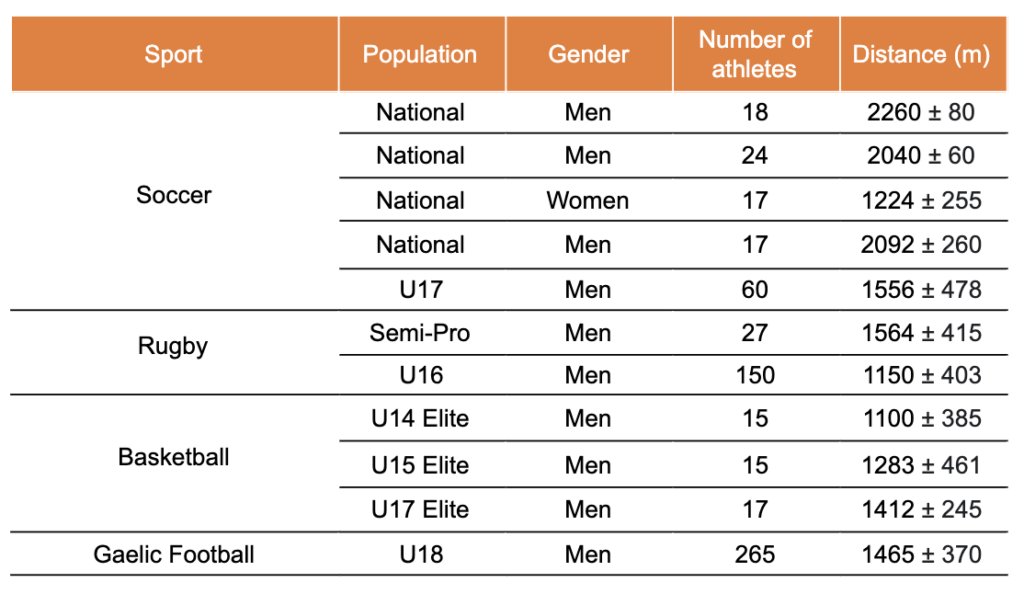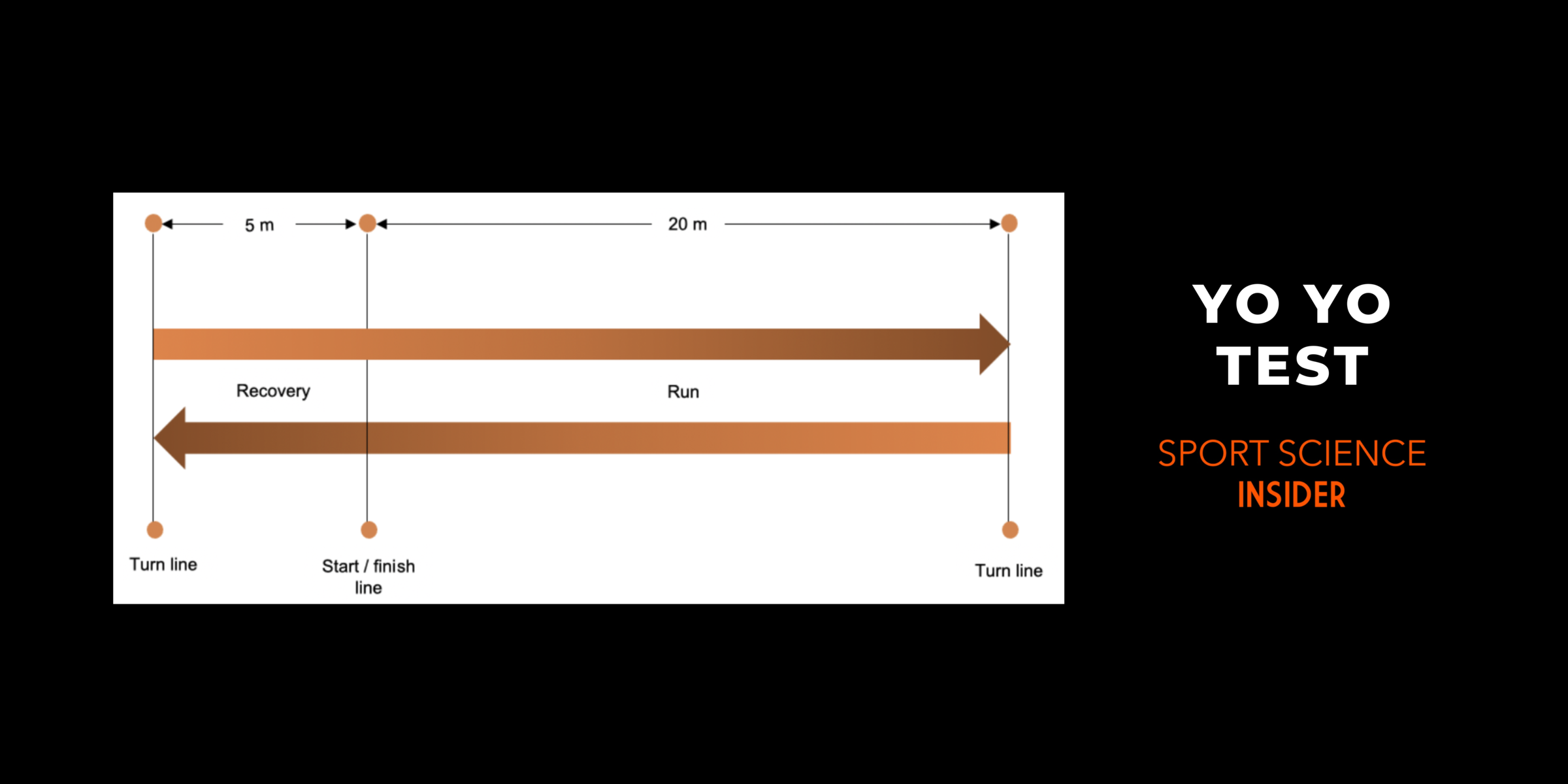In this article, we’re going to cover what the Yo-Yo test is, how to perform the test, discuss the science behind testing and provide normative data for athletes competing in various sports and at various levels.
- What is the Yo-Yo Intermittent Recovery Test?
- Should I choose the level 1 or 2 Yo-Yo test?
- How to perform the Yo-Yo Intermittent Recovery Test?
- How the Yo-Yo Test score is calculated
What is the Yo-Yo Intermittent Recovery Test?
The Yo-Yo Intermittent Recovery Test (IRT) is a maximal test that involves athletes repeatedly completing 2 x 20m shuttle runs at increasing speeds, with a 10-second recovery period between each shuttle, until exhaustion.
This test is used to assess an athlete’s ability to repeatedly perform high-intensity exercise. It has become a highly popular test used in team sports such as football and rugby, which require short intense bursts of running followed by a short period of recovery, due to its specificity and practicality.
There are two variations of the test:
- Yo-Yo Intermittent Recovery Test 1
- Yo-Yo Intermittent Recovery Test 2
Yo-Yo Intermittent Recovery Test Level 1
The Yo-Yo Intermittent Recovery Test level 1 assesses an athlete’s ability to repeatedly perform high-intensity aerobic work and measures an athlete’s endurance capacity. It is the most popular version of the Yo-Yo test and is the recommended test for S&C professionals.
The Yo-Yo level 1 test starts at 10 km/hr and increases the speed at a moderate rate – it consists of 4 shuttles at 10-13 km/h followed by 7 shuttles at 13.5-14 km/h and increases at 0.5 km/h speed increments after every 8 shuttles until exhaustion.
This test typically lasts for 10-20 minutes and is suitable for young or recreational athletes.
Yo-Yo Intermittent Recovery Test Level 2
This test assesses an athlete’s ability to repeatedly perform intense work with a high anaerobic energy contribution along with an aerobic contribution.
The Yo-Yo IR2 test starts at a higher speed (13 km/h) and increases speed initially at a higher rate compared to the Yo-Yo IR1 test – it consists of 2 shuttles at 13 km/h and 15 km/h, followed by 2 shuttles at 16 km/h, 3 shuttles at 16.5 km/h, 4 shuttles at 17km/h and then increases speed at 0.5 km/h increments after every 8 shuttles until exhaustion.
This test typically lasts for 5-15 minutes and is suitable for highly trained athletes i.e., elite, and professional athletes.
Should I choose the level 1 or 2 Yo-Yo test?
Aim to choose the test that best reflects the demands of your sport and/or your athletes. You may also want to consider the time you have to test athletes (if the athletes are fit the Yo-Yo level 1 will take a while!) and the training load they have currently.
How to perform the Yo-Yo Intermittent Recovery Test
To perform the yo-yo test, you will need:
- Cones
- 30m tape measure
- Yo-Yo intermittent recovery test audio tape
- Speaker
- Recording sheet (click here for a pdf recording sheet for Yo-Yo test level 1 and here for Yo-Yo test level 2 from The Complete Guide to the Yo-Yo Test)
- 40m testing area
- Two or more test administrators
Set up for the yo-yo intermittent recovery test:
The figure below demonstrates the setup for the yo-yo test:

- Place three channels of cones in a straight line, 5 and 20m apart (indicated by the orange circles in figure 1).
- One test administrator should stand in line with the start/finish line and the other test administrator should stand in line with the turn line at the 20m mark. If additional test administrators are available, they should assist at the start/finish and 20m turning line.
- One test administrator should set up the audio tape on the speaker – the audio tape will dictate the test and the “beeps” will indicate the start and end of each shuttle.
Test procedure:
- All athletes will line up along the start line.
- The audio tape will provide instructions to the athletes and indicate when to start. Once instructed on the first “beep” to start, the athletes must complete a 20m shuttle run – they must run to the 20m turning line before a second “beep” and then turn with one foot on or over the line and run 20m back to the start line within the allocated time, as indicated by the third “beep”
- The athlete will then have a 10-second recovery period before the next shuttle, during this time they must jog to the 5m turn line and back to the start line and then wait for the next shuttle to start, as indicated by the “beep”.
- At regular intervals, the time to complete each shuttle will reduce, so the athlete will need to increase their running speed to ensure they make each shuttle within the allocated time.
- The test administrators can keep a visual record on which level the test is currently at by marking off each level on the recording sheet as it’s reached.
- The test stops when either the athlete has reached their physical limit and chooses to stop, or if they are given two warnings from the test administrators. The test administrator can mark the initials of the athlete on the recording sheet if/when they receive a warning to help them keep track. Warnings are given to the athlete if:
- They don’t reach the start/finish line on or before the audio signal.
- They start to run before the audio signal.
- They run short of the turning line.
- Once the athlete has stopped the test, their initials is written into the appropriate box on the recording sheet by the test administrators to indicate which level they reached. Please note, if you are completing this test with a group, athletes will be stopping the test at different times so only stop the tape recording when the last athlete has stopped the test.
How the Yo-Yo Test score is calculated
There are three ways we can provide a score for an athlete, these include:
- Level achieved
- Total distance (m)
- VO2 Max
Level Achieved
The athlete’s level achieved is the level of the last shuttle they successfully completed; this can be marked on the recording sheet by placing the athlete’s initials in the appropriate box.
Total Distance
To calculate Yo-Yo test total distance ran by the athlete during the Yo-Yo test, note the number of shuttles the athlete successfully completed and multiply that number by 40 (distance ran per each shuttle).
Example: An athlete completed 25 shuttles
- 25 x 40 = 1,000m
- Total distance ran = 1,000m
VO2 Max
To estimate the athlete’s VO2 max from the results of the Yo-Yo tests, use the formulas below:
How to calculate VO2 Max for the Yo-Yo Test Level 1
Use the following calculation to calculate VO2 Max if you are using the Yo-Yo Test Level 1. All you need to record is the total distance:
- VO2 max (mL*kg-1*min-1) = total distance (m) x 0.0084 + 36.4
How to calculate VO2 Max for the Yo-Yo Test Level 2
Use the following calculation to calculate VO2 Max if you are using the Yo-Yo Test Level 2. All you need to record is the total distance:
- VO2 max (mL*kg-1*min-1) = total distance (m) x 0.0136 + 45.3
Creating valid and reliable data
All fitness tests will give you data, but if you plan to use the data to compare athletes, or re-test the same athlete you need to make sure you perform the test with the following considerations.
These seem small, but they will often hide any real changes in an athlete’s development if they are not controlled.

Normative data for the Yo-Yo Test
Below are average test scores for the Yo-Yo test from published literature. These average test scores should give you an insight into your own test scores. However, please check the full paper (at the bottom of this article) to check you are using the same setup and that the ages of the athletes are comparable.

Yo-yo intermittent recovery test reliability and validity
The Yo-Yo tests have high validity and reliability, with high reproducibility demonstrated after studies observed the same results when tests were repeated within the same week by elite male football players.
The Yo-Yo level 1 test is a sensitive measure of changes in performance and is a moderately reliable predictor of VO2 max.
Frequently asked questions
Where can I find a recording sheet for the yo-yo test?
You can find a PDF copy of a scoring sheet for the Yo-Yo test level 1 by clicking here and for the Yo-Yo test level 2 by clicking here.
What is a good score on the yo-yo test?
We have provided normative values in this article for athletes competing in various sports and at various levels, which you can use to interpret your score.
Below are rating tables that were first created by Top End Sports, where they’ve published scores for what they consider is a very poor, below average, average, good, excellent, and elite score for males and females completing Level 1 and 2 test. To find the original tables and how they determined the categories, please click here.


What does the Yo-Yo test measure?
The Yo-Yo test is used to assess an athlete’s ability to repeatedly perform high-intensity exercise. More specifically, the Yo-Yo test level 1 focuses on an athlete’s ability to repeatedly perform high-intensity aerobic work whereas the Yo-Yo test level 2 focuses on an athlete’s ability to repeatedly perform intense work with a high anaerobic energy contribution in combination with an aerobic contribution.
However, please be aware that these concepts are relative to the level of an individual’s fitness. For example, less fit athletes could quickly hit an anaerobic threshold in the level 1 test. Whereas, athletes with high levels of cardiovascular fitness could have a high level of aerobic contribution in the level 2 test.
Where to find the yo-yo test audio?
You can purchase the Yo-Yo Level 1 and 2 test audio tapes on CD for $2.99 each from The Complete Guide to the Yo-Yo Test here.
You can also access the Yo-Yo Level 1 and 2 test audio tapes for free on YouTube:
- Click here for level 1 – credit to J Serra Boys Soccer.
- Click here for level 2– credit to SF Complete Coaching.
Summary
The Yo-Yo intermittent recovery test is a popular test in sport to assess an athlete’s ability to repeatedly perform high-intensity exercise, due to its specificity, practicality, and normative data to compare results to.
We hope this article has given you all the info you need to run the test, run it well and compare your results to normative data.
For more on fitness testing for athletes check out this article, or if you’d like to learn more about testing agility, check out these articles on the Beep test, 505 Agility test and The Pro Agility test.
Further Reading
- Haff & Triplett (2015) – Essentials of strength training and conditioning 4th edition.
- Bangsbo et al. (2008) – The Yo-Yo intermittent recovery test: a useful tool for evaluation of physical performance in intermittent sports.
- Schmitz et al (2018) – The Yo-Yo intermittent test: A systematic review and structured compendium of test results.
Reference
If you quote information from this page in your work, then the reference for this page is:
Shaw, W (2021). Yo-Yo Test: Complete Guide & Normative Data: Available from: https://sportscienceinsider.com/yo-yo-test/ [Accessed dd/mm/yyyy].
Will is a sport scientist and golf professional who specialises in motor control and motor learning. Will lecturers part-time in motor control and biomechanics, runs Golf Insider UK and consults elite athletes who are interested in optimising their training and performance.

